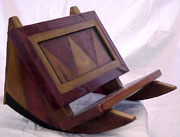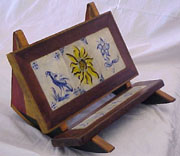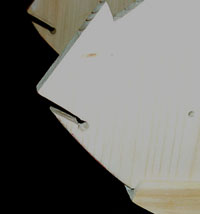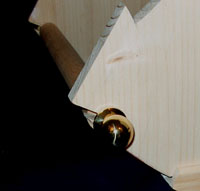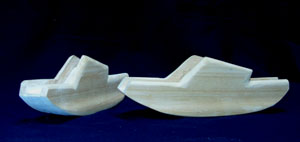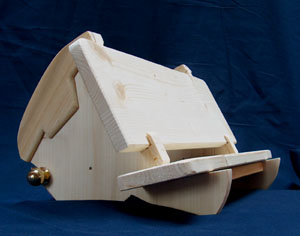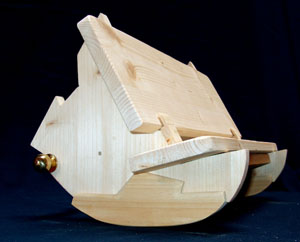|
|
|
|
| Started: |
Last
update: January 25, 2004
|
Finished: |
|
| Jan
18, 2004 |
:
"Bookstand"
foldable, with optional rocking and continuously
adjustable inclination, for tabletop reading
|
Jan
25, 2004
|
|
| |
|
|
|
|
The
idea
|
|
|
I already
constructed several bookstands like the ones shown below. You may
click them to see the catalogue of existing bookstands.
These
are tabletop bookstands used to read seated at a table.
But I also wanted to build a tabletop bookstand which would have
the following characteristics or objectives:
1- It
could be either stable or rocking in order to adjust its inclination.
2- The inclination would be adjustable continuously, which means
that any angle of inclination could be obtained.
3- It could be assembled and dissaembaled without any screws, nails
nor glue.
|
|
|
|
|
|
|
|
|
|
The
idea was to cut the rounded base of the supports so that it could
be removed (shown in orange colour in the sketch above).
Let's call it the 'sabot' S
or wooden shoe.
The problem then was how or where to store that movable piece
.
I thought of cuting also the left top side of the supports so
that it could accomodate the movable 'sabot' when not use to rock
the bookstand. Both configuration are shown on the sktech above.
The
other 2 caracteristics were obtained, not at this basic design
level, but step by step as I construted the model dscribed below.
This is an interesting design methodology whereby some basics
are decided early and the rest comes upon on a trial and error
approach, always keeping in mind the objectives.

Catalogue
- Catalogo
|
|

|
|
|
|
|
| Execution
- Component pieces |
|
|
|
The
shape of the sabot S should
be such that it holds in place both under and on the resting side
of the bookstand.
I wanted
to exactly describe the work I did and the process I followed in
arriving at a solution. It was an interesting writing exercise.
Clarity with words is the essence of technology, even when dealing
with an artistic project.
Technology
comes from the greek "tecne-logos" where "tecne"
means art and "logos" verbal discourse:
Technolgy
means "verbal description of an art".

|
|
Combining
art and technology may therefore just be a convenient pleonasm!

Click
here to read the complete design story
|
|
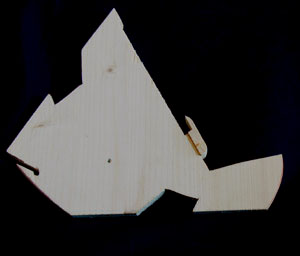
The leg
or support
|
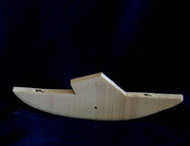
The 'sabot'
or wooden shoe
|
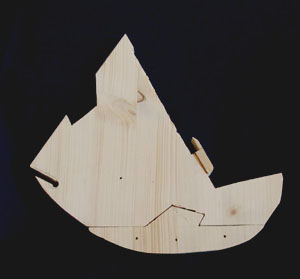
The sabot
fit at the base of the leg
for rocking the bookstand.
|
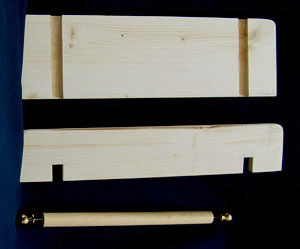
The other
3 elements are the back rest board (top),
the horizontal plane (middle) and a round bar with screwedin knobs
whose use is shown below right
|

The sabot
also fits on the left side of the leg
when not used for rocking the bookstand.
|
| |
|
|
|
|
The round
bar with the knobs fits into the split shown at left. The knobs can be
screwed to tighten the bar on the legs.
A big problem
remained to be solved. How to prevent the sabots to slip away from the
legs.
|
|
|
|
|
|
|
|
The solution
was to cut larger shapes of the sabot from a thin sheet of wood and glue
2 of them on each side of the sabot.
The sabot
will not move sideaways once inserted in either position on the leg.
|
|
| Execution
- Assembling |
|
|
|
First insert
the legs in the dents of the horizontal plane.
Then place
the screws inserted at each end of the round bar in the splits of the
legs and screws on the knobs as tight as necessary to make the construction
rigid.
|
|
|
|
|
Insert the
back rest board into the space provided on the legs.
Place the
sabot on the back side of the legs if you so desir...
|
|
|
|
... or place
them under for rocking the bookstand.
Another round
bar is provied which can be rolled under the sabot to adjust the inclination
in a continuous manner.
This bar is decorated with the same knobs used for screwing the consolidation
bar in the back of the legs.
Click
the image right 
|
|
|
|
The
job now is to decorate the piece to look like old precious wood.
Patience!
 Here it is!
Here it is!
|

|
